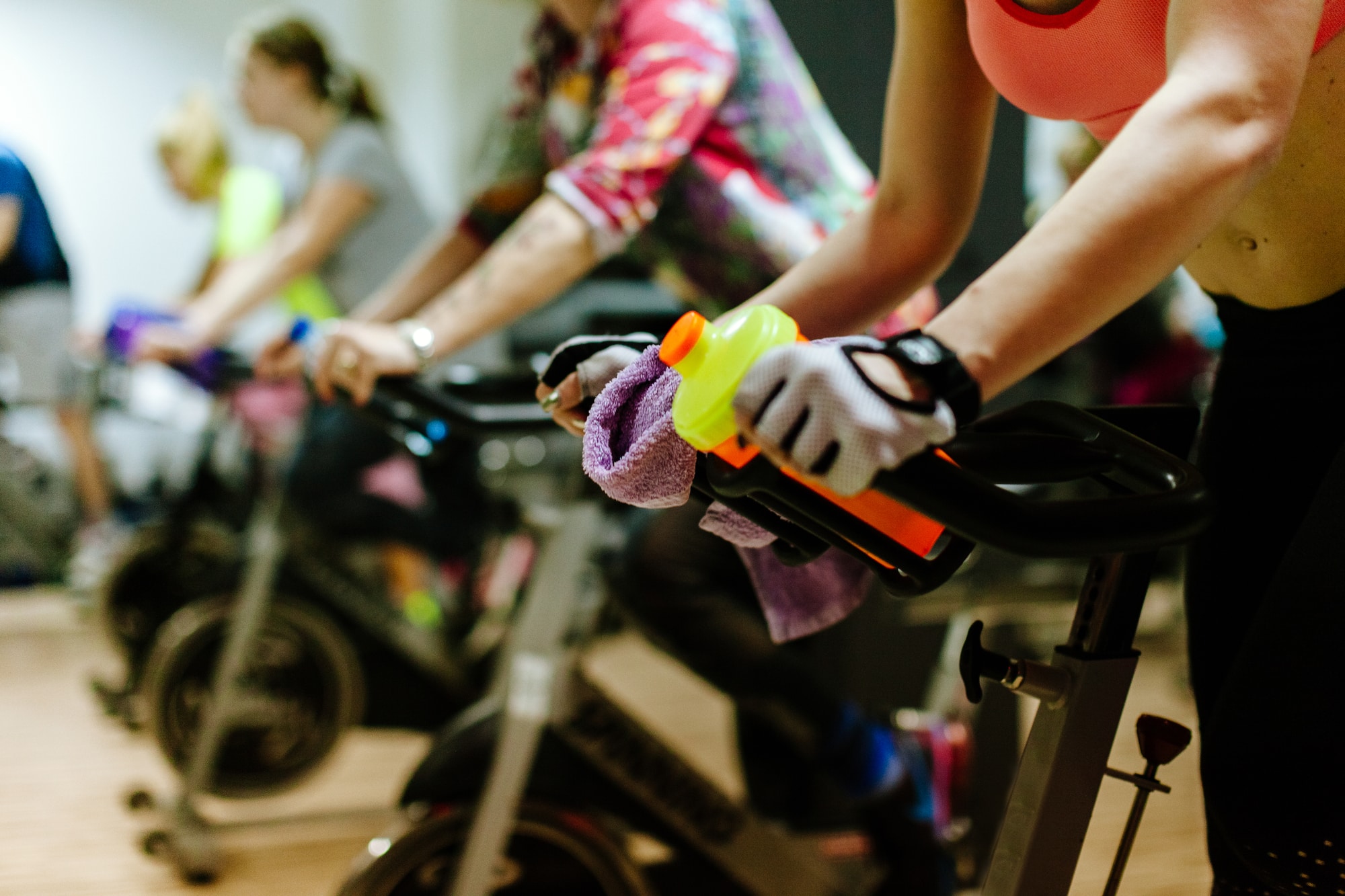How to Avoid Injuries While Using an Exercise Bike
This entry was posted on September 29, 2023.

In the realm of fitness, indoor cycling has gained significant popularity. However, improper use of exercise bikes can lead to injuries, disrupting your fitness regimen.
Understanding how to avoid injuries while using an exercise bike is crucial to maintaining a healthy and sustainable workout routine.
This post from Fitness Expo will delve into the nature of these injuries and underscore the importance of preventative measures in ensuring you get the most out of your indoor cycling experience without compromising your health.
Recognizing Common Indoor Cycling Injuries

Symptoms of Overuse Injuries
Indoor cycling injuries often sneak up on you. You might feel a twinge after an intense indoor cycling class, but brush it off. Gradually, that twinge becomes a constant ache. This is an overuse injury.
Areas Most Affected
The most common victims are your knees, back, and wrists. These areas bear the brunt of the pressure during indoor cycling. For instance, tight hip flexors can lead to knee pain.
Acute vs. Chronic Injuries
There’s a difference between acute and chronic exercise bike injuries. An acute injury happens suddenly – think sprained wrist or pulled muscle. Chronic injuries develop over time due to repeated strain.
The Role of Poor Posture
Poor posture is like an uninvited guest at your workout party. It can cause discomfort and eventually lead to injury. Slouching on your residential bike? Hello, back pain! Gripping the handlebars too tightly? Your wrists won’t be happy.
Remember, prevention is better than cure. Adjust your bike properly before starting your workout session, and maintain good posture throughout.
Implementing Safe Cycling Intensity Progression

Gradual Intensity Increase
When you’re hitting the exercise bike, don’t go full throttle from the get-go. It’s crucial to gradually increase your workout intensity. This way, you avoid shocking your muscles and reduce injury risk.
Warm-Up Matters
Before hopping on your bike, take time for warm-up exercises. Stretch those muscles out a bit! This prepares them for the upcoming intense activity and helps prevent strains or sprains.
Heart Rate Monitoring
Keep an eye on your heart rate during workouts. It’s a reliable indicator of how hard you’re pushing yourself. If it spikes too high, ease off a bit – overworking can lead to injuries.
Rest Periods are Essential
Don’t underestimate the power of rest periods to prevent overexertion. After all, even machines need downtime for maintenance! Regular breaks between cycling sessions give your body time to recover and rebuild stronger than before.
Addressing Wrist, Forearm, and Foot Pain
Indoor cycling can sometimes lead to wrist and forearm pain. The culprit? Improper hand positioning on the handlebars.
- Gripping too tight or resting your entire weight on your hands can cause discomfort.
- Incorrect handlebar height might also contribute to this problem.
Knee, Back, and Shoulder Pain Prevention
Knee, back, and shoulder pain are common ailments that can significantly impact daily activities and overall quality of life. Understanding preventive measures and adopting proactive strategies can play a vital role in safeguarding these key areas and ensuring long-term physical well-being.
Correct Bike Seat Position
The link between incorrect seat height or position and knee or back pain is real. If your bike seat is too high or low, it can cause knee injuries. Adjusting the seat to the right position helps you avoid this.
For example:
- Too High: Strains your knees
- Too Low: Puts pressure on your back muscles
So, check with a physical therapist to get the correct posture.
Body Alignment Matters
Your body alignment during biking sessions influences shoulder stress. The wrong posture can lead to muscle tightness in the shoulders. Keeping your neck and shoulders relaxed while exercising can prevent this.
Core Strength Importance
Core strength plays a major role in supporting back health while using an exercise bike. A strong core stabilizes your back and prevents pain. Regular workouts that strengthen core muscles are beneficial for maintaining good posture on the bike.
Take Regular Breaks
Taking regular breaks during workout routines is necessary to alleviate pressure on the knees, back, and shoulders. Over-exercising leads to unnecessary stress in these areas, causing pain and discomfort.
Remedies for Exercise Bike-Related Injuries
Injuries from exercise bikes can be a real pain. Let’s look at some remedies to help you recover faster.
Ice Packs for Quick Relief
Ice packs are your first line of defense against minor strains or sprains. Applying an ice pack to the affected area can reduce swelling and numb the pain. Just remember not to apply ice directly to your skin.
- Always wrap it in cloth
- Apply it for 15 minutes at a time
- Repeat every two hours
Physiotherapy as a Long-Term Solution
For chronic injuries, physiotherapy could be your ticket out of pain. A trained physiotherapist can guide you through exercises that strengthen muscles and improve flexibility, reducing the chance of future injuries.
Over-the-counter Medications Can Help
Over-the-counter (OTC) medications like ibuprofen or acetaminophen can manage pain effectively. They’re readily available and often provide quick relief.
Note: Don’t rely solely on these medications long-term without consulting a healthcare professional.
Seek Medical Advice for Persistent Symptoms
If symptoms persist or worsen, don’t hesitate to seek medical advice. Doctors can diagnose your condition accurately and recommend appropriate treatments.
Remember, prevention is better than cure. So always warm up before hopping onto that exercise bike, maintain proper form while pedaling, and listen to your body’s signals when it needs rest.
Final Thoughts
In conclusion, proper use and maintenance of an exercise bike can help prevent any unwanted injuries. Spreading out physical activity instead of doing the same move over and over again with repetitive movements can be very effective in avoiding fatigue and strain.
If you have any questions that arise during your biking routine, have your fitness goals in mind, or need help maintaining a steady routine, visit Fitness Expo today!
With these simple tips in mind to help keep you safe while working out with an exercise bike, we hope our readers find success and satisfaction today and into the future. Contact us today!
FAQs
-
What are some common injuries from using an exercise bike?
Common injuries from using an exercise bike often include wrist and forearm pain due to improper handlebar grip or positioning; foot pain resulting from incorrect pedal technique; and knee, back, and shoulder pain caused by poor posture or overuse.
-
How can I prevent knee pain when cycling indoors?
Preventing knee pain when cycling indoors involves ensuring proper bike setup (seat height and position), maintaining correct posture during workouts, warming up before starting intense sessions, cooling down afterward, and progressively increasing workout intensity.
-
Can I still use an exercise bike if I have previous injuries?
Yes. However, it’s advisable to consult with a healthcare provider or physiotherapist first. They can guide safe practices based on your specific condition.
-
How do I know if my exercise bike is set up correctly?
A properly set up exercise bike should allow you to maintain good posture throughout your workout. Your knees should slightly bend at the bottom of each pedal stroke, and your elbows should also slightly bend when holding onto the handlebars.
-
What should I do if I experience pain during or after my workout?
If you experience persistent pain during or after your workout, it’s important to pause your exercise routine and consult a healthcare provider. They can help identify the cause of the discomfort and recommend suitable remedies or modifications.



